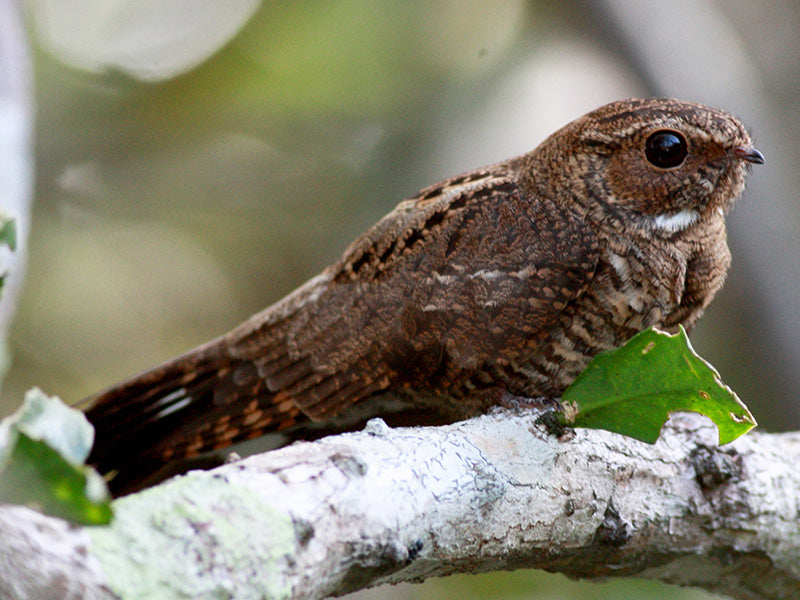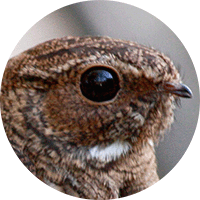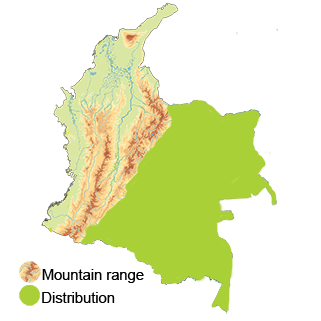Band-tailed Nighthawk
The Band-tailed Nighthawk (Nyctiprogne leucopyga) Read in Spanish
Appearance: The Band-tailed Nighthawk (Nyctiprogne leucopyga) is a medium-sized, nocturnal bird with a distinctive appearance. It has a mottled brown and gray plumage that provides camouflage against tree bark and rocks. The bird features a band of white on its tail, which is prominent during flight. It has a short, slightly curved bill and large eyes adapted for low-light vision.
Habitat and Range: The Band-tailed Nighthawk is found in various habitats across Colombia, including open woodlands, savannas, grasslands, and forest edges. It may also occur in urban areas with suitable roosting sites and abundant insect prey. This species is known to inhabit both lowland and montane regions of Colombia.
Behavior: Band-tailed Nighthawks are primarily crepuscular and nocturnal, being most active during dawn and dusk. They are skilled aerial hunters, capturing insects in flight using their agile flight and sharp talons. During the day, they roost on branches or concealed perches, relying on their cryptic plumage for camouflage.
Breeding: Breeding behaviors of Band-tailed Nighthawks in Colombia may include courtship displays involving aerial acrobatics and vocalizations. Nests are usually simple scrapes on the ground or in rocky crevices, where the female lays one or two eggs. Both parents participate in incubating the eggs and caring for the young.
Conservation Status: The conservation status of the Band-tailed Nighthawk may vary regionally based on habitat loss, fragmentation, and other threats.
Distribution
The Band-tailed Nighthawk (Nyctiprogne leucopyga)
Amazon Region: In the Amazon region of Colombia, Band-tailed Nighthawks may occur in the vast expanse of tropical rainforests, riverine habitats, and floodplains. This region offers rich biodiversity and abundant insect prey for nighthawks.
Orinoquía Region: Within the Orinoquía region of Colombia, which includes savannas, wetlands, and gallery forests, Band-tailed Nighthawks may inhabit open grasslands and riparian areas. The diverse habitats of this region provide opportunities for nighthawks to thrive.
Taxonomy
The Chotacabras Coliblanco (Nyctiprogne leucopyga)
- Kingdom: Animalia
- Phylum: Chordata
- Class: Aves (Birds)
- Order: Caprimulgiformes
- Family: Caprimulgidae
- Genus: Nyctiprogne
- Species: Nyctiprogne leucopyga
Vocalization
The Band-tailed Nighthawk (Nyctiprogne leucopyga)
- Churring Calls: Band-tailed Nighthawks are known to produce churring calls that consist of a series of rhythmic, guttural, and repetitive sounds. These calls are often used for communication between individuals, especially during the breeding season or while maintaining contact within a group or pair.
- Crooning or Purring Sounds: Some descriptions mention that Band-tailed Nighthawks can emit soft, crooning or purring sounds, which may be part of courtship displays or interactions between mates.
- Booming or Resonant Calls: During territorial displays or confrontations with rivals, Band-tailed Nighthawks may produce booming or resonant calls that sound deep and authoritative. These calls are often used to establish dominance or defend territories.
- Alarm Calls: When sensing danger or detecting predators nearby, Band-tailed Nighthawks may release sharp and rapid alarm calls to alert other nighthawks and coordinate protective responses.
- Flight Display Sounds: While in flight, Band-tailed Nighthawks may create whirring or swishing sounds with their wings, especially during aerial displays or hunting pursuits.





